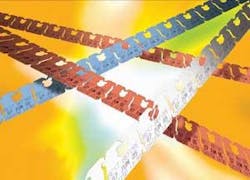Widnes, Cheshire - Kwik Lok Australia Pty. Ltd. will be adopting Sherwood Technology’s (www.sherwoodttech.com) DataLase Masterbatch color change technology to date code bread bag closures for George Weston Foods (GWF). GWF is one of Australia’s largest food manufacturers, with more than 75 percent of Australian households buying its bread. The bread is sealed using Kwik Lok all-plastic bag closures, which are marked to provide information on cost, freshness, and other package information.
Traditionally Kwik Lok worked with laser vendor Markem Corp. to apply the data to the bread bag closures using a thermal transfer printer; however, GWF found that the information tended to rub off the closures. As a result, GWF requested that Kwik Lok, Unimark (Markem’s agent), and Sherwood Technology work together to provide an alternative date coding solution. Unimark has supplied GWF with a number of Markem CO2 laser units in the first phase, although the intention is to eventually use color change technology as the default date coding method across all new lines at GWF.
Kwik Lok applies DataLase Masterbatch directly to the bread bag closure polymer by extrusion. The additive is non-toxic and environmentally friendly, and is capable of producing an image when marked by a low-power CO2 laser (around 10 W). Once exposed to the laser on the production line, the additive undergoes a simple color change to create a stable and high-contrast date code that cannot be removed easily from the closures. Reportedly, the introduction of this solution has also resulted in faster production run times for the company and removed the need for expensive consumables on the production line.
